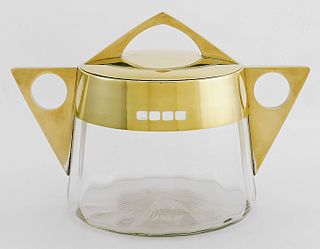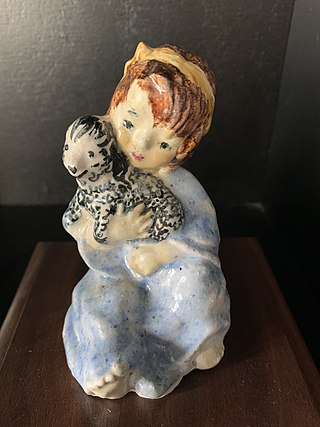
The Neue Galerie New York is a museum of early twentieth-century German and Austrian art and design located in the William Starr Miller House at 86th Street and Fifth Avenue in New York City. Established in 2001, it is one of the most recent additions to New York City's famed Museum Mile, which runs from 83rd to 105th streets on Fifth Avenue in the Upper East Side of Manhattan.

The Wiener Werkstätte, established in 1903 by the graphic designer and painter Koloman Moser, the architect Josef Hoffmann and the patron Fritz Waerndorfer, was a productive association in Vienna, Austria that brought together architects, artists, designers and artisans working in ceramics, fashion, silver, furniture and the graphic arts. The Workshop was "dedicated to the artistic production of utilitarian items in a wide range of media, including metalwork, leatherwork, bookbinding, woodworking, ceramics, postcards and graphic art, and jewelry." It is regarded as a pioneer of modern design, and its influence can be seen in later styles such as Bauhaus and Art Deco.

The Vienna Secession is an art movement, closely related to Art Nouveau, that was formed in 1897 by a group of Austrian painters, graphic artists, sculptors and architects, including Josef Hoffman, Koloman Moser, Otto Wagner and Gustav Klimt. They resigned from the Association of Austrian Artists in protest against its support for more traditional artistic styles. Their most influential architectural work was the Secession exhibitions hall designed by Joseph Maria Olbrich as a venue for expositions of the group. Their official magazine was called Ver Sacrum, which published highly stylised and influential works of graphic art. In 1905 the group itself split, when some of the most prominent members, including Klimt, Wagner, and Hoffmann, resigned in a dispute over priorities, but it continued to function, and still functions today, from its headquarters in the Secession Building. In its current form, the Secession exhibition gallery is independently led and managed by artists.

Koloman Moser was an Austrian artist who exerted considerable influence on twentieth-century graphic art. He was one of the foremost artists of the Vienna Secession movement and a co-founder of Wiener Werkstätte.

Anton Hanak was an Austrian sculptor and art Professor. His works tend to have a visionary-symbolic character, related to Expressionism.

Josef Hoffmann was an Austrian-Moravian architect and designer. He was among the founders of Vienna Secession and co-establisher of the Wiener Werkstätte. His most famous architectural work is the Stoclet Palace, in Brussels, (1905–1911) a pioneering work of Modern Architecture, Art Deco and peak of Vienna Secession architecture.

Michael Powolny was an Austrian sculptor, medallist, ceramist, designer, and teacher.

Karl Hagenauer (1898–1956) was an influential Austrian designer in the Art Deco style.
Werkstätte Hagenauer Wien - (wHw) - was a family business in Vienna that produced fine, handcrafted objects for decoration and use over its nearly ninety-year history. The workshop closed in 1987 but the company's retail premises, opened in 1938 on Vienna's Opernring, survives today as a museum and shop.

Gisela Falke Von Lilienstein was an Austrian designer who designed ceramics, glassware, jewelry, lighting, and furniture for the Wiener Werkstätte. Her work was exhibited in Vienna Secessionist exhibitions and international expositions.
Maria Auböck is an Austrian landscape architect and educator. In 1985, she opened her own firm where, since 1987, she has been working together with János Kárász.

Mathilde Flögl was an Austrian artist and designer. She worked in several different mediums including textiles, glass, and paint. Flögl was also a member of the Wiener Werkstätte, literally translated to the Vienna Workshops. This group was part of the Arts and Crafts movement dedicated to elegance, utility, and appropriateness. They aimed to refine art and expand it to all fields of life. Flögl was very active in this group, she participated in most of the major Wiener Werkstätte exhibitions. Currently, the Viennese Museum of Applied Arts houses over 1,600 of Flögl's works from when she was involved with the Wiener Werkstätte. Among these are many independent works and collaborations with other individuals in the group. Notable members of the Wiener Werkstätte include two of its founders Josef Hoffman and Koloman Moser as well as Gustav Klimt, among others. For the group's 25th anniversary, Flögl amassed, arranged, wrote, and published, The Wiener Werkstatte, 1903-1928: The Evolution of the Modern Applied Arts. The book itself was a work of art using elaborate materials and decoration in its pages.

Susi Singer, also known as Selma Singer-Schinnerl, was an Austrian-American Jewish ceramic artist known for her bright and detailed figurines.
The Gallia family Hoffman apartment collection is a set of furniture and decorative objects that are the surviving Vienna Secession style contents of the 1913 apartment of wealthy Austrian businessman Moritz Gallia and his wife and Hermine, mostly designed by leading architect and designer Josef Hoffman. When the Gallia's children had to flee the Anschluss with Nazi Germany in 1938, they brought what remained with them to Australia, a place 'as far away as they could get', where it was subsequently purchased in 1976 by National Gallery of Victoria, and pieces have been on permanent display since 1984.
Edith "Ditha" Moser (1883–1969) was an Austrian artist and an influential member of the artistic group Vienna Secession.
Gudrun Baudisch, later Gudrun Baudisch-Wittke was an Austrian ceramist, sculptor and painter. Baudisch founded the Keramik Hallstatt workshop.

Friedrich Waerndorfer, originally Wärndorfer, was an Austrian entrepreneur, patron of the arts, and founding member of the Wiener Werkstätte. He was also known as Fred Warndorf.

Ena Rottenberg was a Hungarian-Austrian craftswoman, draftswoman, ceramist and member of the artists' community of the Wiener Werkstätte.

Eduard Josef Wimmer-Wisgrill was an Austrian industrial designer, architect, and fashion designer. He was active in the first half of the 20th century. Wimmer is best known for his work in jewelry and garments for the Wiener Werkstätte, as well as for his contributions to the field of modern architecture.















